Food Pantries
Senior Food Pantries - Senior-Meals.org
How Your Local Food Pantry May Be a Resource for Family Caretakers and their Loved Ones
Perhaps you are an individual who has found yourself unexpectedly taking care of a loved one, which can inevitably increase your food costs, and as a result, also put a strain on your finances. However, your loved one has to eat, so what do you do?
When food is scarce in the home, many families, family caretakers, and more often turn to their local food pantries for help.
What is a Food Pantry?
A food pantry is a nonprofit, 503(c), or another type of food charity organization that provides immediate food help to those in need. However, some food distribution organizations also provide other much-needed resources as well, such as seasonal food packages, health screenings, nutrition education, and more.
They are often located in various communities throughout the regions to provide immediate food assistance to residents in local areas who are in need, and quite often, they are the only source of free food assistance in a community.
A food pantry is typically established in a permanent location; however, there are also mobile food distributions, as well.
Their food supply often consists of healthy, nutritious foods that are sourced from various contributors, including individual donors whose help is typically provided via food drives where individual donations are made in the form of canned goods and other nonperishable food items.
Some food pantries also collaborate with local establishments, such as restaurants, who proudly donate their edible surpluses. Sometimes local gardeners also donate their extra produce.
However, the majority of food pantries often depend on much larger food banks who receive larger donations from local and national businesses, such as growers, retailers, and manufacturers, nonprofit organizations, state government aid, and sometimes even other food banks themselves who donate their surpluses, which enables the food bank to provide a steady supply of free, nutritious foods to local food pantries, including dairy products, fresh produce, meats, breads, and canned goods.
Food pantries, similarly to any food establishment, are also required to store their food properly to help ensure clients receive safe, uncontaminated food. This means, they keep a close eye out for signs of spoiled food, and they also inspect the food expiration dates before offering food to their clients to ensure it is safe to eat.
Additionally, food pantries are also kept clean and free of pest contamination for safe food distribution. Likewise, no food is stored near cleaning supplies, chemicals, or other physical hazards to also help ensure your safety.
How Food Pantries Work
Many food pantries operate within regular business hours, during which time clients are free to walk in and receive food help; however, they must complete an application and initial interview first. In more dire food emergencies, anyone who comes to the pantry can receive an emergency food package; however, they are encouraged to complete an application upon returning for future help.
Once you have completed an application, your application will be assessed, and you will be asked a few questions, such as why you are in need of food help and how many people are in your household, to determine if you are eligible, as well as to examine your household's needs. Some state and federal programs may also require certain information, such as supporting documents as well as some form of I.D. to confirm your eligibility.
Once you are officially registered, most pantries enable clients to schedule monthly appointments for nonperishable staples. However, in addition to the monthly appointment, clients can also enjoy designated walk-in days as well as daily visits for certain perishables, such as bread and produce.
Food pantries distribute food to their clients in different ways, depending on the pantry. However, the most common means of distribution are usually standardized food box or bag pantry and the client choice pantry.
The standardized food box or bag pantry prepares standard packages of food, which consists of a nutritional balance of foods, to give to its clients. This way, each client is provided with pretty much the same quantity of food to help ensure fairness.
On the other hand, client choice pantries are often arranged similarly to small grocery stores with products neatly organized on shelves and in freezers and coolers to enable clients to select their own food choices according to their individual preferences. However, there are some client choice pantries that provide their clients with a list of food items they have available and then prepare individual bags or boxes according to the client's selections.
And then there are mobile pantries, which do not operate via a building but instead borrow a large space, such as a parking lot, for a few hours to provide their clients with food. On the day of service, the food is dropped off to the pantry's site where they usually have a number of tables set up to hold the food. Once the clients complete the short entrance interview, they simply stroll the tables, similar to shopping a Farmer's Market, and select the items they like. Once the event is over, the organization packs up any remaining food along with the tables and any other clutter to ensure the site is as clean as it was before they arrived.
How a Senior, Elderly, or Family Caretaker Can Utilize Local Food Pantries to Feed Themselves or a Loved One
Provided you are a senior, elderly, or family caretaker, and more, whose household income is at 200%, or less, of the federal poverty level, you are eligible for food pantry assistance.
When it comes to how to find a food pantry in your community, you have several options for finding them. For instance, you can begin by simply conducting an internet search to find local food pantries near you. There are several online sites that enable you to search by state for a list of food pantries available in your area.
You could also try contacting your local food bank to locate food pantries in your area. Since they often supply local food pantries with goods, they will know what pantries are near you. Your local U.S Department of Jobs and Family Services will also be able to provide you with information on local food pantries.
Whenever mobile food pantries have an event, they often pass out announcements in the community to let potential clients know when and where the food distribution will take place, so you should also remain on the lookout for these type of fliers.
Lastly, when in doubt about where to find food help, you can always visit local churches in your area who often have food pantries of their own and can help.

Our reviews are written only
from the viewpoint of a family caretaker who has the responsibility of feeding one or two senior or elderly loved ones. We take into consideration shipping, packaging, storage, reheating, food quality, and price per meal to determine if the meal delivery service is a good value, convenience, and an option to support their family caretaking responsibilities. Advertisers do not influence our reviews.
Copyright 2013 Senior-Meals.org All Rights Reserved. Art commercially licensed through Shutterstock. Senior-Meal.org reviews are not influenced by Advertisers.
Submitting reviews or comments through the use of forms on the website permits us to publish the content you choose to share in your correspondence.



